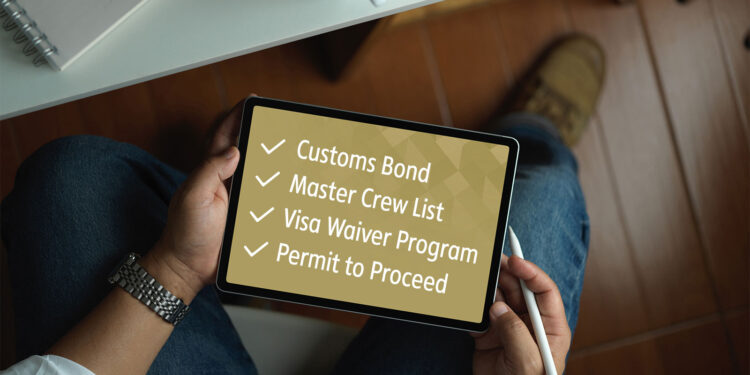Permissions for Non-U.S. Charter Flights to the U.S. – Part 1: General Requirements

This business aviation blog post is part of a series on permissions non-U.S. charter operators when traveling to the U.S.
When operating charters (non-schedued commercial) to/from the U.S., with non-U.S. registered aircraft, there are many considerations to be mindful of. Particular procedures and/or documentation requirements must be complied with, depending upon the country of registry of your aircraft.
The following is an overview of what you need to know:
1. APIS requirements
Advanced passenger information system (APIS) must be filed prior to departing to/from the U.S. and prior to notifying U.S. CBP of a customs clearance request. While there’s generally no limit on how early you may submit APIS requests, it’s best not to do this too far ahead of the estimated time of arrival/departure, to avoid issues with submitting changes. Be aware that charter operators must have a registered “carrier code” prior to filing APIS.
2. TSA waivers
The first entry/last exit into/out of the U.S. is considered APIS controlled, and no Transportation Security Administration (TSA) waiver is needed. Domestic movement by non-U.S. charter flights may require a TSA waiver depending on aircraft weight and country of registration. TSA waivers take about five business days to process and are valid up to 90 days. TSA only processes waiver requests during normal business hours Monday-Friday with no night, weekend or holiday availability. While short notice waivers are possible, this is at TSA’s discretion.
3. TSA waiver tips
When applying for TSA waivers it’s best to include all airports in the U.S. that you may possibly operate to and from. Note that there are two special-case airports, in relation to general aviation (GA) movements. Washington National (KDCA) requires both a special TSA waiver and specific additional documentation. Andrews AFB (KAFW), on the other hand, is restricted for all GA operations and cannot be used even if included in a waiver request. Information required to obtain a TSA waiver includes operator, crew and passenger details, aircraft information and itinerary. If any information is missing you will not be able to complete your TSA waiver request online. Be aware that when applying for a 90 day TSA waiver it’s necessary to state start and end dates. For revisions, allow five business days to have waivers updated. For more information on TSA waivers, please see previous articles we have written on our blog.
4. Customs notification
Lead time for customs notification varies depending upon the airport of entry (AOE). Each AOE requires 1) APIS to be submitted prior to your departure for the U.S. (and when departing the U.S.) and 2) notification to clear customs at the AOE must be provided. APIS must always be filed prior to notifying Customs of your arrival. Be aware that CBP overtime availability depends upon the airport. Airports are normally allocated a certain amount of overtime each year. Overtime options for clearing customs, in practice, are better earlier in the year rather than later – as they tend to get used up.
5. Charter frequency limitations
Charter operators of foreign-registered aircraft are allowed up to six trips to the U.S. annually without a permit. One trip is defined as one entry and exit, to/from the U.S., with an unlimited number of associated domestic legs. After this limit is reached you’ll need to arrange a 375 exemption. This allows the operator to make an additional six charter trips during the year. 129 exemptions are also available, authorizing an unlimited number of charter movements to the U.S. for a year, but this is a much more time- and document-intensive process. 375 exemptions are processed by the Department of Transport (DOT), and your trip support company can assist in obtaining this on your behalf. Lead time for 375 exemptions is about 30 business days. Information required includes applicant name, address, company executive or board member name (i.e. President or CEO), a list of all aircraft under the operator name, details of proposed operations, an explanation of the type of business to be done in the U.S., and a copy of the Air Operator Certificate (AOC), issued by the authority under which the aircraft is registered. 375 exemptions are valid for one year from the date obtained. Note that 129 exemptions should be processed directly with DOT, utilizing an aviation law firm as opposed to a 3rd-party provider, and the process usually requires 90-120 days to complete.
6. Mexican- and Canadian-registered charter operations
Unlike other foreign-registered operators, Mexican and Canadian operators are not limited in terms of number of charter flights they may make to the U.S. each year. This is due to bilateral agreements between the countries involved.
A special exemption known as the 49 USC 40109, valid for two years, is available for Mexican-registered charter operators from the U.S. DOT. Your trip support provider may assist in obtaining these exemptions. Required operator information is similar to the 375, but operators must also provide income records for the past 90 days to prove financial solvency. Lead time for Mexican exemptions is 60 business days, with 30 days lead time for renewals. Note that in the case of renewals it’s not necessary to submit income records.
Canadian-registered charter flights have a similar exemption available, also obtained from the U.S. DOT.
7. Additional information is available
For more information pertaining to DOT permissions for non-US registered aircraft operating charter flights to the U.S. see: http://www.dot.gov/policy/aviation-policy/licensing/foreign-carriers
Conclusion
Some non-U.S. operators are unfamiliar with the full range of regulations and permissions involved in operating charters to/from the U.S. It’s always best to work closely with your 3trip support provider to avoid any potential issues.
Questions?
If you have any questions about this article or would like assistance obtaining your needing permissions for the U.S., contact me at juanmuniz@univ-wea.com.
Later, we’ll discuss additional considerations for non-U.S. charter operators traveling to the U.S.



